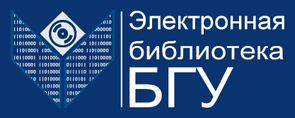Пожалуйста, используйте этот идентификатор, чтобы цитировать или ссылаться на этот документ:
https://elib.bsu.by/handle/123456789/304260Полная запись метаданных
| Поле DC | Значение | Язык |
|---|---|---|
| dc.contributor.author | Зноско, К. Ф. | |
| dc.contributor.author | Лещик, С. Д. | |
| dc.contributor.author | Лискович, А. А. | |
| dc.date.accessioned | 2023-11-03T13:27:43Z | - |
| dc.date.available | 2023-11-03T13:27:43Z | - |
| dc.date.issued | 2023 | |
| dc.identifier.citation | Взаимодействие излучений с твердым телом : материалы 15-й Междунар. конф., Минск, Беларусь, 26-29 сент. 2023 г. / Белорус, гос. ун-т ; редкол.: В. В. Углов (гл. ред.) [и др.]. – Минск : БГУ, 2023. – С. 70-72. | |
| dc.identifier.issn | 2663-9939 (Print) | |
| dc.identifier.issn | 2706-9060 (Online) | |
| dc.identifier.uri | https://elib.bsu.by/handle/123456789/304260 | - |
| dc.description | Секция 1. Процессы взаимодействия излучения и плазмы с твердым телом = Section 1. Processes of radiation and plasma interaction with solids | |
| dc.description.abstract | Представлены результаты экспериментального исследования абляции алюминия, меди и нержавеющей стали сдвоенными наносекундными импульсами с энергией 50 мДж (25 мДж+25 мДж). Показано, что максимальный вынос материала (толщина аблированного слоя) происходит при межимпульсном интервале равном 1 мкс. Для алюминия он составлял ~5.5 мкм, для меди ~2.5 мкм и для нержавеющей стали 1.67 мкм за один сдвоенный импульс. При моноимпульсной абляции вынос материала составлял ~0.53 мкм для алюминия, 0.21 мкм для меди и 0.18 мкм для нержавеющей стали. Таким образом, эффективность лазерной абляции сдвоенными лазерными импульсами при межимпульсном интервале в 1 мкс в ~5 раз выше для алюминия, в ~6 раз выше для меди и в ~4.5 раза выше для нержавеющей стали, по сравнению с моноимпульсной абляцией (в расчете на единицу затраченной энергии лазерного излучения) | |
| dc.language.iso | ru | |
| dc.publisher | Минск : БГУ | |
| dc.rights | info:eu-repo/semantics/openAccess | |
| dc.subject | ЭБ БГУ::ЕСТЕСТВЕННЫЕ И ТОЧНЫЕ НАУКИ::Физика | |
| dc.title | Лазерная абляция цветных металлов сдвоенными наносекундными импульсами YAG:Nd3+-лазера | |
| dc.title.alternative | Laser ablation of non-ferrous metals by double nanosecond pulses of YAG:Nd3+ laser / K.F. Znosko, S.D Leshchyk, A.А. Liskovich | |
| dc.type | conference paper | |
| dc.description.alternative | The results of an experimental study of the ablation of aluminum, copper and stainless steel by dual nanosecond pulses with an energy of 50 mJ (25 mJ + 25 mJ) are presented. It is shown that the maximum removal of material (the thickness of the ablated layer) occurs at an interpulse interval of 1 μs. For aluminum, it was ~5.5 µm, for copper, ~2.5 µm, and for stainless steel, 1.67 µm in one double pulse. With monopulse ablation, the material removal was ~0.53 µm for aluminum, 0.21 µm for copper, and 0.18 µm for stainless steel. Thus, the efficiency of laser ablation with double laser pulses at an interpulse interval of 1 μs is ~5 times higher for aluminum, ~6 times higher for copper, and ~4.5 times higher for stainless steel, compared with single-pulse ablation (calculated per unit of expended energy of laser radiation). The material removal by the second laser pulse relative to the first one was calculated. With an inter-pulse interval of 1 μs, the removal of material by the second laser pulse exceeds the removal of material by the first pulse by ~9.5 for Al, ~11 for Cu, and ~8 for stainless steel. With an increase in the interpulse interval, the removal of material by the second laser pulse decreases compared to the first one. Already at τ~5 μs, it decreases by 1.5 times. At τ~50 μs, the removal of material is reduced by almost half. This is due to a decrease in the temperature of the erosion crater remaining after the action of the first laser pulse over time | |
| Располагается в коллекциях: | 2023. Взаимодействие излучений с твердым телом | |
Все документы в Электронной библиотеке защищены авторским правом, все права сохранены.

